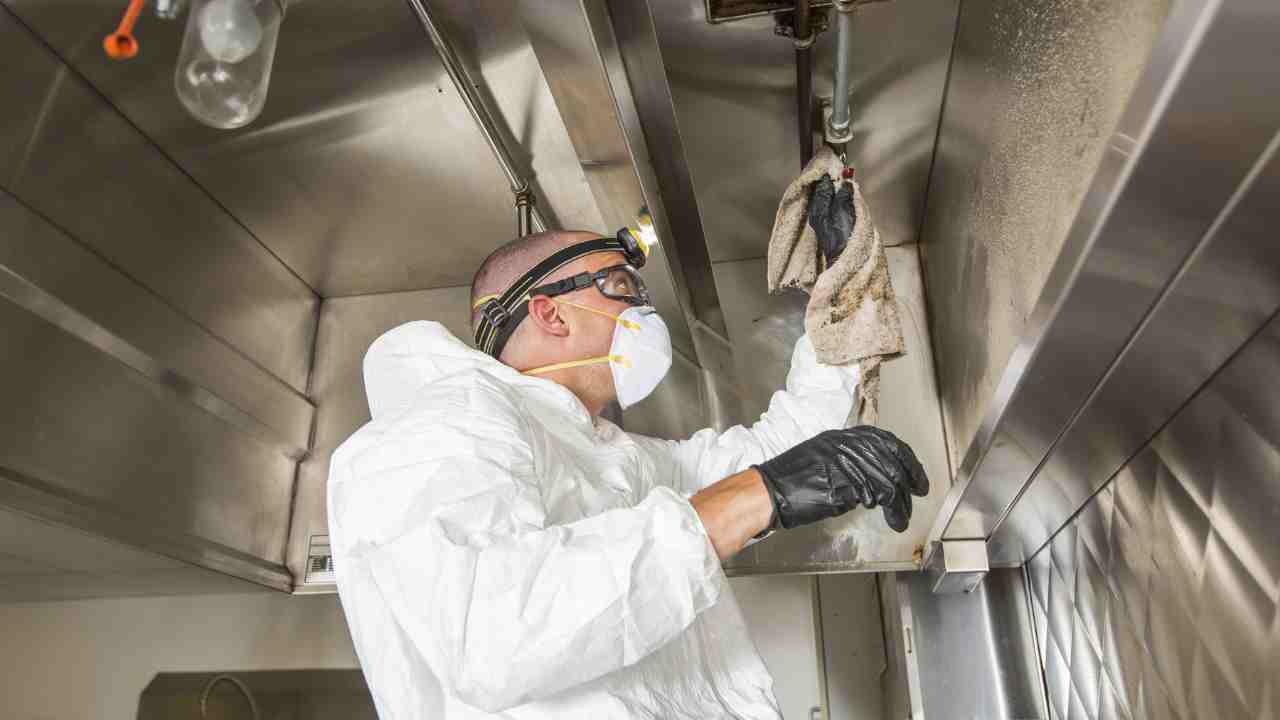Kitchen Exhaust Cleaning Safety

Ontario-wide Kitchen Exhaust and Hood Cleaning – Best prices and service guaranteed.
Keeping a kitchen clean and safe is essential for any food establishment. One crucial aspect of kitchen maintenance is the regular cleaning of kitchen exhaust systems. These systems remove grease, smoke, and other pollutants from the air, ensuring a healthy and comfortable environment for both employees and customers. However, kitchen exhaust cleaning can be a hazardous task if not performed with proper safety measures. In this article, we will explore the importance of kitchen exhaust cleaning safety and provide valuable insights on how to ensure a safe and effective cleaning process.
The Importance of Kitchen Exhaust Cleaning
Before diving into the safety aspects, it is crucial to understand why kitchen exhaust cleaning is so important. Kitchen exhaust systems accumulate grease and other flammable substances over time, which can pose serious fire hazards. According to the National Fire Protection Association (NFPA), cooking equipment was involved in 61% of all reported home structure fires between 2014 and 2018. The majority of these fires were caused by the ignition of flammable materials, such as grease, in the kitchen area.
Regular cleaning of kitchen exhaust systems not only reduces the risk of fire but also improves the overall air quality in the kitchen. Grease and smoke particles can accumulate on surfaces, including walls, ceilings, and cooking equipment, leading to unpleasant odors and potential health issues. By removing these pollutants, kitchen exhaust cleaning helps maintain a clean and healthy environment for both employees and customers.
Ontario-wide Kitchen Exhaust and Hood Cleaning – Best prices and service guaranteed.
The Hazards of Kitchen Exhaust Cleaning
While kitchen exhaust cleaning is essential, it can also be a hazardous task if not approached with caution. The following are some of the potential hazards associated with kitchen exhaust cleaning:
- Slip and fall accidents: Cleaning kitchen exhaust systems often involves working at heights and on slippery surfaces. Without proper safety measures, workers can easily slip and fall, leading to severe injuries.
- Chemical exposure: Cleaning agents used in kitchen exhaust cleaning can contain harsh chemicals that can be harmful if not handled properly. Workers may experience skin irritation, respiratory issues, or other health problems if exposed to these chemicals without proper protection.
- Fire hazards: Kitchen exhaust systems are prone to grease buildup, which can ignite and cause a fire if not cleaned regularly. Working with flammable materials increases the risk of fire accidents if proper precautions are not taken.
- Electrical hazards: Kitchen exhaust systems are often connected to electrical components, such as fans and motors. Working on these systems without proper knowledge and precautions can lead to electrical shocks or other electrical accidents.
Ontario-wide Kitchen Exhaust and Hood Cleaning – Best prices and service guaranteed.
Ensuring Kitchen Exhaust Cleaning Safety
To ensure the safety of workers and the effectiveness of the cleaning process, it is crucial to follow proper safety guidelines. Here are some essential steps to ensure kitchen exhaust cleaning safety:
1. Training and Certification
Before performing kitchen exhaust cleaning, workers should receive proper training and certification. Training programs should cover topics such as safety procedures, chemical handling, and the use of personal protective equipment (PPE). Certification ensures that workers have the necessary knowledge and skills to perform cleaning tasks safely and effectively.
Ontario-wide Kitchen Exhaust and Hood Cleaning – Best prices and service guaranteed.
2. Personal Protective Equipment (PPE)
Wearing appropriate personal protective equipment is essential to minimize the risk of injuries and chemical exposure. Workers should wear gloves, goggles, and respiratory protection when handling cleaning agents or working in confined spaces. PPE helps protect workers from chemical splashes, respiratory hazards, and other potential dangers.
3. Proper Equipment and Tools
Using the right equipment and tools is crucial for safe and effective kitchen exhaust cleaning. High-quality cleaning equipment, such as pressure washers and steam cleaners, can help remove grease and other contaminants efficiently. Additionally, workers should have access to sturdy ladders, scaffolding, and safety harnesses when working at heights.
Ontario-wide Kitchen Exhaust and Hood Cleaning – Best prices and service guaranteed.
4. Safe Work Practices
Following safe work practices is essential to minimize the risk of accidents during kitchen exhaust cleaning. Some important practices include:
- Ensuring proper ventilation in the kitchen area to prevent the accumulation of hazardous fumes.
- Using non-slip mats and wearing slip-resistant footwear to prevent slip and fall accidents.
- Using caution signs and barricades to alert others about the cleaning activities and prevent unauthorized access to the work area.
- Turning off electrical power to the kitchen exhaust system before starting the cleaning process to avoid electrical accidents.
- Using proper lockout/tagout procedures when working on electrical components to prevent accidental energization.
5. Regular Inspections and Maintenance
Regular inspections and maintenance of kitchen exhaust systems are crucial to identify potential hazards and ensure their proper functioning. Inspections should include checking for grease buildup, loose electrical connections, and any signs of damage or wear. By addressing these issues promptly, the risk of accidents can be significantly reduced.
Ontario-wide Kitchen Exhaust and Hood Cleaning – Best prices and service guaranteed.
Kitchen exhaust cleaning safety is of utmost importance to prevent fire hazards, maintain a clean environment, and protect the well-being of workers. By following proper safety guidelines, including training and certification, using personal protective equipment, using the right equipment and tools, practicing safe work habits, and conducting regular inspections and maintenance, the risk of accidents can be minimized. Ensuring kitchen exhaust cleaning safety not only protects lives and property but also contributes to the overall success and reputation of food establishments.
Learn more about “Prudent Practices Of Kitchen Exhaust Cleaning Process” right here.
Frequently asked questions about Kitchen Exhaust Cleaning Safety

What is kitchen exhaust cleaning, and why is it important for safety? 🍳🧽🔥
Kitchen exhaust cleaning is the process of removing grease, dirt, and other contaminants from the ventilation system of commercial kitchens. This system includes exhaust hoods, ductwork, fans, and filters. It’s crucial for safety because, over time, grease buildup in the exhaust system can become a fire hazard. The accumulated grease can ignite, leading to dangerous kitchen fires that can spread rapidly. Regular cleaning not only ensures a safer cooking environment but also maintains proper airflow, improves air quality, and helps kitchen equipment work efficiently, reducing the risk of fires and health issues.
How often should I have my kitchen exhaust system cleaned? 🗓️🧼🔧
The frequency of kitchen exhaust cleaning depends on the type of establishment, cooking volume, and the type of food being prepared. High-volume kitchens like restaurants and cafeterias typically require more frequent cleaning, which could be every three to six months. Moderate-volume kitchens may need cleaning every six to twelve months, while low-volume kitchens might need annual cleaning. However, it’s essential to follow local fire and safety codes, as they often stipulate specific cleaning schedules to ensure compliance and safety.
What are the potential risks of neglecting kitchen exhaust cleaning? 🚫🔥🌫️
Neglecting kitchen exhaust cleaning can lead to several risks. The most significant risk is an increased likelihood of grease fires. The accumulated grease can ignite easily, and since exhaust systems distribute air throughout the building, a fire in the exhaust can quickly spread to other areas. Poorly maintained systems can also hinder proper airflow, leading to smoke and odors lingering in the kitchen, affecting air quality and staff comfort. Furthermore, neglected systems might not filter out contaminants effectively, leading to potential health issues and non-compliance with hygiene regulations.
Are there any safety precautions I should take during kitchen exhaust cleaning?
Absolutely! Safety is paramount during kitchen exhaust cleaning. First, ensure the kitchen is shut down, and all cooking equipment is cold to prevent accidents. Wear appropriate personal protective equipment (PPE) like gloves, eye protection, and masks to safeguard against cleaning chemicals and contaminants. Make sure the cleaning equipment is in good condition and well-maintained. Adequate ventilation is crucial, so open windows and doors or use fans to ventilate the area. If you’re not experienced, consider hiring professionals who are trained to handle cleaning chemicals, equipment, and challenging cleaning tasks safely.
How can I choose a reliable kitchen exhaust cleaning service? 🧽🛠️👨🍳
When selecting a kitchen exhaust cleaning service, there are a few key factors to consider. Look for companies with a solid reputation and experience in the industry. Ask for references and read reviews from previous clients to gauge their reliability and quality of service. Ensure they follow industry standards and guidelines and are certified by relevant organizations. It’s essential to obtain a detailed estimate that outlines the scope of work, including cleaning methods, equipment, and schedule. Don’t hesitate to ask questions about their cleaning process, safety protocols, and insurance coverage before making your decision.







